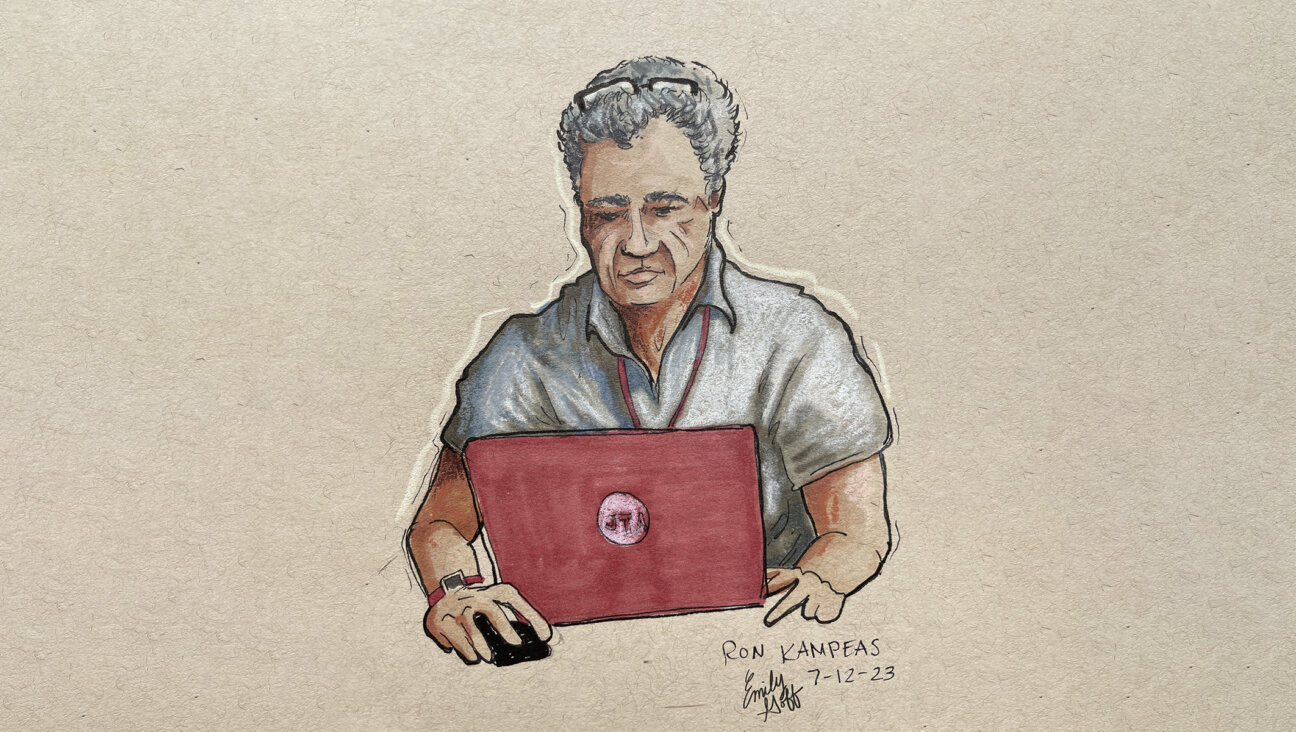New Research by Israeli Scientists Shows Imprints of Brain Activity

At Weizmann: Researchers Rafael Malach and Tal Harmelech, pushing the boundaries of brain research. Image by Courtesy of Rafael Malach
It is well known that the patterns of activity in the human brain change according to the different tasks that people are performing. But could it be that an imprint of these patterns remains on the brain hours and even days later, like footprints in the sand?
At the Weizmann Institute of Science in Rehovot, Israel, home to a Nobel laureate and three Turing Award laureates, neurobiology professor Rafael Malach claims to have evidence that such a record remains — for 24 hours, at least.
The recent discovery — part of an Israeli initiative to push the boundaries of brain science — raises the possibility of a future in which the human mind could be explored for its record of past events.
Malach told the Forward that his research, just published in the Journal of Neuroscience, “points to a new brain imaging approach which has the potential to uncover traces of previous brain events.” It could open the door to numerous innovations, some of which sound like science fiction.
Tal Harmelech, the doctoral student under Malach’s supervision who conducted the research, said: “In theory, this could make it possible to read someone’s past from his or her resting brain waves — at least to a limited extent.
“In other words, we might have a method of decoding not only what a person is thinking right now, but what were his or her meaningful thoughts in the last few days.”
While the United States is in the midst of a major push on brain research, with President Obama’s April announcement of a $100 million initiative to unlock the “enormous mystery” of the brain, his Israeli counterpart beat him to it in setting priorities. In September 2012, President Shimon Peres launched a prize for an individual or team anywhere in the world who could demonstrate an extraordinary breakthrough in brain technology with global implications. The $1 million prize is administered by the not-for-profit Israel Brain Technologies.
Peres said when launching the prize: “With its reputation as a ‘start-up’ nation, renowned for its innovative and creative initiatives and its focus on science and technology as an engine for economic development, Israel is well-positioned to assume a leadership role in the emerging neurotechnology industry that promises to make the world a better place.”
Brain research in Israel is thriving. In 2009 Hebrew University established the Edmond and Lily Safra Center for Brain Sciences, and in July construction began for a state-of-the-art 150,000 square-foot building for the institute. And Peres is constantly raising the profile of the topic. A session in June at the Israeli Presidential Conference, which he oversees, was devoted to it.
At Weizmann, Malach has believed for some time that the brain patterns of people who are resting represent a code to valuable information. During such a rest period, the normal bursts of nerve cell activity associated with incoming information are replaced by ultraslow patterns of neuronal activity. The spontaneous waves during rest travel in a highly organized manner through the brain’s outer layer — the cortex — and the patterns they create are complex, yet periodic and symmetrical.
To explore this belief, Harmelech recruited volunteers and got them to undertake a task that is known to create certain patterns in the brain, revealed through functional magnetic resonance imaging. Based on their task, they received auditory feedback from the target brain region, and were asked to increase it using a cognitive strategy. She then asked her subjects to rest, and repeated the fMRI scans on their brains.
She found that the patterns of brain activity that occurred during their task remained even during the rest period. The scans, more specifically, revealed an increase in “functional links” between different parts of the brain activated during the tasks and a decrease in such links in those areas of the brain not engaged in the tasks.
More surprising, when she repeated the scan during a second rest period 24 hours later, the patterns of brain activity from the task were still detectable — and even a little stronger.
“There is a trace of previous cortical activity… a sort of ‘archive’ of our past experiences,” said Harmelech. “Every time we learn something new we’re changing our brain a little.”
The ultimate test for her findings, she says, will be a blinded version of the experiment: Scientists will try to identify which tasks were done by which subjects by looking at the brain images alone.
If the blinded experiment is successful and scientists are able to identify which tasks people had been doing simply by looking at their MRIs, what might the implications be some day? Could such mind reading be an opportunity for law enforcement — albeit one that would provoke a major debate regarding personal privacy? Harmelech considers it possible that “criminal acts have certain brain signatures” and that traces of these signatures could be detectable after the event.
“Maybe one day we’ll be able to build a library of patterns linking particular experiences with the observable activity they produce,” she said.
Harmelech, a modest 30-year-old, is not one to talk up her research, but if it survives further probing, she envisions some mind-boggling applications.
For one, it could help doctors identify the nature of a patient’s brain disorder.
Scans could distinguish “how the patterns of connectivity in their brains differ from those of healthy individuals,” she commented. It could, for example, provide a way of telling when a seemingly unconscious patient actually has locked-in syndrome — a condition that leaves people unable to move or communicate even though they are conscious.
Imprints of brain patterns may some day offer a window into uncovering each individual’s abilities, shortcomings, biases and learning skills.
Perhaps personality profiling could be a brain-science equivalent to genome profiling.
Contact Nathan Jeffay at [email protected]
A message from our Publisher & CEO Rachel Fishman Feddersen

I hope you appreciated this article. Before you go, I’d like to ask you to please support the Forward’s award-winning, nonprofit journalism during this critical time.
We’ve set a goal to raise $325,000 by December 31. That’s an ambitious goal, but one that will give us the resources we need to invest in the high quality news, opinion, analysis and cultural coverage that isn’t available anywhere else.
If you feel inspired to make an impact, now is the time to give something back. Join us as a member at your most generous level.
— Rachel Fishman Feddersen, Publisher and CEO






















